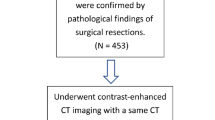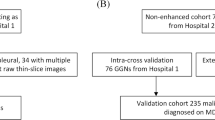Abstract
Objectives
Adenocarcinoma in situ (AIS) and minimally invasive adenocarcinoma (MIA) are assumed to be indolent lung adenocarcinoma with excellent prognosis. We aim to identify these lesions from invasive adenocarcinoma (IA) by a radiomics approach.
Methods
This retrospective study was approved by institutional review board with a waiver of informed consent. Pathologically confirmed lung adenocarcinomas manifested as lung nodules less than 3 cm were retrospectively identified. In-house software was used to quantitatively extract 60 CT-based radiomics features quantifying nodule’s volume, intensity and texture property through manual segmentation. In order to differentiate AIS/MIA from IA, least absolute shrinkage and selection operator (LASSO) logistic regression was used for feature selection and developing radiomics signatures. The predictive performance of the signature was evaluated via receiver operating curve (ROC) and calibration curve, and validated using an independent cohort.
Results
402 eligible patients were included and divided into the primary cohort (n = 207) and the validation cohort (n = 195). Using the primary cohort, we developed a radiomics signature based on five radiomics features. The signature showed good discrimination between MIA/AIS and IA in both the primary and validation cohort, with AUCs of 0.95 (95% CI, 0.91–0.98) and 0.89 (95% CI, 0.84–0.93), respectively. Multivariate logistic analysis revealed that the signature (OR, 13.3; 95% CI, 6.2–28.5; p < 0.001) and gender (OR, 3.5; 95% CI, 1.2–10.9; p = 0.03) were independent predictors of indolent lung adenocarcinoma.
Conclusion
The signature based on radiomics features helps to differentiate indolent from invasive lung adenocarcinoma, which might be useful in guiding the intervention choice for patients with pulmonary nodules.
Key points
• Based on radiomics features, a signature is established to differentiate adenocarcinoma in situ and minimally invasive adenocarcinoma from invasive lung adenocarcinoma.




Similar content being viewed by others
Abbreviations
- AIS:
-
Adenocarcinoma in situ
- AUC:
-
Area under the curve
- CT:
-
Computed tomography
- IA:
-
Invasive adenocarcinoma
- LASSO:
-
Least absolute shrinkage and selection operator
- MIA:
-
Minimally invasive adenocarcinoma
References
Travis WD, Brambilla E, Noguchi M et al (2011) International Association for the Study of Lung Cancer/American Thoracic Society/European Respiratory Society International Multidisciplinary classification of lung adenocarcinoma. J Thorac Oncol 6:244–285
Travis WD, Brambilla E, Nicholson AG et al (2015) The 2015 World Health Organization classification of lung tumors: impact of genetic, clinical and radiologic advances since the 2004 classification. J Thorac Oncol 10:1243–1260
Yoshizawa A, Motoi N, Riely GJ et al (2011) Impact of proposed IASLC/ATS/ERS classification of lung adenocarcinoma: prognostic subgroups and implications for further revision of staging based on analysis of 514 stage I cases. Mod Pathol 24:653–664
Woo T, Okudela K, Mitsui H et al (2012) Prognostic value of the IASLC/ATS/ERS classification of lung adenocarcinoma in stage I disease of Japanese cases. Pathol Int 62:785–791
Kadota K, Villena-Vargas J, Yoshizawa A et al (2014) Prognostic significance of adenocarcinoma in situ, minimally invasive adenocarcinoma, and nonmucinous lepidic predominant invasive adenocarcinoma of the lung in patients with stage I disease. Am J Surg Pathol 38:448–460
Liu S, Wang R, Zhang Y et al (2016) Precise diagnosis of intraoperative frozen section is an effective method to guide resection strategy for peripheral small-sized lung adenocarcinoma. J Clin Oncol 34:307–313
Yeh YC, Nitadori J, Kadota K et al (2015) Using frozen section to identify histological patterns in stage I lung adenocarcinoma of </= 3 cm: accuracy and interobserver agreement. Histopathology 66:922–938
Gillies RJ, Kinahan PE, Hricak H (2016) Radiomics: images are more than pictures, they are data. Radiology 278:563–577
Verma V, Simone CB, Krishnan S, Lin SH, Yang J, Hahn SM (2017) The rise of radiomics and implications for oncologic management. J Natl Cancer Inst. https://doi.org/10.1093/jnci/djx055
Lee G, Lee HY, Park H et al (2017) Radiomics and its emerging role in lung cancer research, imaging biomarkers and clinical management: state of the art. Eur J Radiol 86:297–307
Son JY, Lee HY, Lee KS et al (2014) Quantitative CT analysis of pulmonary ground-glass opacity nodules for the distinction of invasive adenocarcinoma from pre-invasive or minimally invasive adenocarcinoma. PLoS One 9:e104066
Chae HD, Park CM, Park SJ, Lee SM, Kim KG, Goo JM (2014) Computerized texture analysis of persistent part-solid ground-glass nodules: differentiation of preinvasive lesions from invasive pulmonary adenocarcinomas. Radiology 273:285–293
Hwang IP, Park CM, Park SJ et al (2015) Persistent pure ground-glass nodules larger than 5 mm: differentiation of invasive pulmonary adenocarcinomas from preinvasive lesions or minimally invasive adenocarcinomas using texture analysis. Invest Radiol 50:798–804
Hawkins S, Wang H, Liu Y et al (2016) Predicting malignant nodules from screening CT scans. J Thorac Oncol 11:2120–2128
Ost DE, Gould MK (2012) Decision making in patients with pulmonary nodules. Am J Respir Crit Care Med 185:363–372
Aerts HJ, Velazquez ER, Leijenaar RT et al (2014) Decoding tumour phenotype by noninvasive imaging using a quantitative radiomics approach. Nat Commun 5:4006
McNeish DM (2015) Using Lasso for predictor selection and to assuage overfitting: a method long overlooked in behavioral sciences. Multivariate Behav Res 50:471–484
Jiang Y, Zhang Q, Hu Y et al (2016) ImmunoScore signature: a prognostic and predictive tool in gastric cancer. Ann Surg 267:504–513
Guo BL, Ouyang FS, Yang SM et al (2017) Development of a preprocedure nomogram for predicting contrast-induced acute kidney injury after coronary angiography or percutaneous coronary intervention. Oncotarget 8:75087–75093
Rios Velazquez E, Parmar C, Liu Y et al (2017) Somatic mutations drive distinct imaging phenotypes in lung cancer. Cancer Res 77:3922–3930
Lee SH, Lee SM, Goo JM et al (2014) Usefulness of texture analysis in differentiating transient from persistent part-solid nodules (PSNs): a retrospective study. PLoS One 9:e85167
Song SH, Park H, Lee G et al (2017) Imaging phenotyping using radiomics to predict micropapillary pattern within lung adenocarcinoma. J Thorac Oncol 12:624–632
Coroller TP, Agrawal V, Huynh E et al (2017) Radiomic-based pathological response prediction from primary tumors and lymph nodes in NSCLC. J Thorac Oncol 12:467–476
Coroller TP, Grossmann P, Hou Y et al (2015) CT-based radiomic signature predicts distant metastasis in lung adenocarcinoma. Radiother Oncol 114:345–350
Huang YQ, Liang CH, He L et al (2016) Development and validation of a radiomics nomogram for preoperative prediction of lymph node metastasis in colorectal cancer. J Clin Oncol 34:2157–2164
Zhang JX, Song W, Chen ZH et al (2013) Prognostic and predictive value of a microRNA signature in stage II colon cancer: a microRNA expression analysis. Lancet Oncol 14:1295–1306
Bankier AA, MacMahon H, Goo JM, Rubin GD, Schaefer-Prokop CM, Naidich DP (2017) Recommendations for measuring pulmonary nodules at CT: a statement from the Fleischner Society. Radiology. https://doi.org/10.1148/radiol.2017162894
Davnall F, Yip CS, Ljungqvist G et al (2012) Assessment of tumor heterogeneity: an emerging imaging tool for clinical practice? Insights Imaging 3:573–589
Funding
This study has received funding by Shanghai Hospital Development Center (16CR3116B).
Author information
Authors and Affiliations
Corresponding authors
Ethics declarations
Guarantor
The scientific guarantor of this publication is Chang Chen.
Conflict of interest
The authors of this manuscript declare no relationships with any companies whose products or services may be related to the subject matter of the article.
Statistics and biometry
One of the authors has significant statistical expertise.
Informed consent
Written informed consent was waived by the institutional review board.
Ethical approval
Institutional review board approval was obtained.
Methodology
• retrospective
• observational
• performed at one institution
Electronic supplementary material
ESM 1
(DOCX 432 kb)
Rights and permissions
About this article
Cite this article
She, Y., Zhang, L., Zhu, H. et al. The predictive value of CT-based radiomics in differentiating indolent from invasive lung adenocarcinoma in patients with pulmonary nodules. Eur Radiol 28, 5121–5128 (2018). https://doi.org/10.1007/s00330-018-5509-9
Received:
Revised:
Accepted:
Published:
Issue Date:
DOI: https://doi.org/10.1007/s00330-018-5509-9




